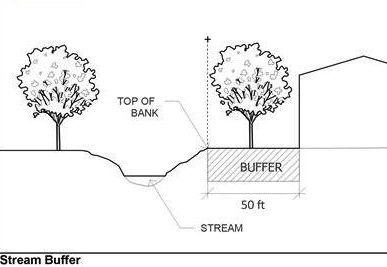No citywide stream buffer in place, Council to consider Water Dept. hydrology map

Philadelphia’s new zoning code went live late last month, but a key environmental provision—providing a 50-foot buffer to development for the city’s rivers and streams—won’t take effect until City Council approves, by ordinance, a hydrology map being prepared by the Water Department. And until that approval comes—late this month, at the earliest—waterways that aren’t protected under separate laws are theoretically vulnerable to the construction of roads, structures and parking lots up to their very banks.
Although the threat does seem to be largely theoretical for now, it wouldn’t have existed at all under the code originally adopted by Council last December. The requirement that Council approve the PWD’s map was added just before the end of the spring Council session, under advisement of the Development Workshop, a group that advocates for development-friendly planning and zoning laws.
Within fifty feet of the banks of the city’s waterways, the original provision prohibits “permanent or temporary structures, except for structures accessory to public open space, clearing of native or non-invasive vegetation, outdoor storage of materials, roads and driveways, parking lots,” and “any other directly connected impervious surface.”
As part of its “clean-up bill” intended to add small edits and corrections to the zoning code before it took effect, the Planning Commission added language to the stream buffer provision stating its purpose to be “to restore the City’s water resources, including drinking water sources; maintain the base flow of streams; reduce erosion and sedimentation; control stormwater runoff; stabilize stream banks; and restore riparian habitats.”
The Development Workshop argued against the addition, successfully, saying that it was a matter of policy rather than a technical amendment. A handful of amendments introduced by Councilmen Bill Green and Bobby Henon in a separate bill and passed instead of the Commission’s clean-up amendments left out the additional statement of purpose for the stream buffers. The Green/Henon bill included the provision requiring Council to approve the hydrology map before the stream buffer goes into effect.
A few weeks ago, Councilman Green’s office organized a working group to discuss the legislation necessary to enact the stream buffer, in hopes of crafting an ordinance that will be ready to introduce when Council reconvenes. The group included representatives of the Planning Commission, the Water Department, PennFuture, the Schuylkill River Development Corporation, the Building Industry Association and, because Council approval is required, each District Councilmember’s office. The group also included the Development Workshop.
The meetings were not announced to the public, but according to those in attendance, the Water Department used the opportunity to explain its hydrology map to District Council members. Part of the reason Council delayed the stream buffer provision in June was that its members didn’t see the map until the morning of the committee hearing concerning the clean-up bill.
The meetings were “a lot of education,” according to Eva Gladstein, deputy director of the City Planning Commission. She said the group discussed various benefits of waterway setbacks, and came to a not-quite-unanimous consensus on what the contents of Council’s ordinance should be.
“There is kind of a path to moving forward, legislatively speaking,” Gladstein said.
According to Gladstein, the eventual legislation should look much like the bill that was delayed in June—and should include the stream buffer purpose statement that gave Council pause in the first place.
The consensus, Gladstein said, is “very consistent with what we had proposed.”
“I would say there was a consensus on a portion of it,” said Craig Schelter of Development Workshop, “but there is not yet a consensus in terms of what the situation is with regard to portions of the rivers.”
Schelter said that enacting a 50-foot buffer on privately owned portions of the Delaware River, for example, is an overreach by the Planning Commission and Water Department. He said he sees the benefit of setbacks on the smaller streams and waterways throughout the City, but that he’s “still not convinced” the buffer is needed on the rivers. And he said he questions the Commission’s motivation in trying to implement it.
“Our concern,” said Schelter, “is that this is more a way of ultimately trying to ensure that you get a public trail along the river” without the City paying to acquire the land.
He said that during the meetings he raised the idea that the City may be trying to use zoning to do something they should really be doing through condemnation and acquisition. But Gladstein and others made it clear that wasn’t the case, Schelter said.
Andrew Sharp, of the environmental group PennFuture, said he felt the delay of the stream buffer represented “an attempt to undo a really open, transparent, accountable process.” He said that his group’s view was that the fifty-foot buffer to development on all waterways serves crucial environmental aims, and that its implementation is “non-negotiable.”
“This was settled policy,” Sharp said. “Council voted on it, and developers are trying to rehash it.”
Contact the reporter at jaredbrey@gmail.com and follow him on Twitter @jaredbrey
WHYY is your source for fact-based, in-depth journalism and information. As a nonprofit organization, we rely on financial support from readers like you. Please give today.



